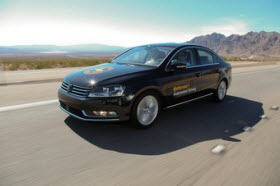With the wealth of benefits that self-driving technology will bring, cars that take control are inevitable. But losing the thrill of driving isn’t.
 When a government agency declares the country is "at a historic turning point for automotive travel," I'm not apt to believe it at face value. Last week, the National Highway Traffic Safety Administration said that autonomous vehicles would completely change our relationship with carsin the next two decades, unlike any advances we've seen in the past century.
When a government agency declares the country is "at a historic turning point for automotive travel," I'm not apt to believe it at face value. Last week, the National Highway Traffic Safety Administration said that autonomous vehicles would completely change our relationship with carsin the next two decades, unlike any advances we've seen in the past century.
These are bold declarations. But NHTSA is correct, and it wants to prepare drivers for this sea change.
You may already own a car with self-driving technology, such as Volvo's City Safety system, which automatically brakes before a collision. Yet while these systems can take control from the driver, you should realize that fully autonomous cars won’t take the fun out of driving. If anything, they'll mitigate the parts that aren't so fun.
Self-driving technology is already here in some ways. Driver assist systems currently available in production cars are gradually taking over more of the mundane tasks from humans, such as staying within a lane or keeping pace with traffic, and are making driving safer and less stressful.
Features such as lane-keeping assist and collision avoidance are now available primarily on higher-end vehicles. But they are starting to trickle down to less expensive cars. Subaru’s EyeSight system will apply the brakes automatically to avoid a collision when a vehicle in front slows or stops, while the 2014 Kia Cadenza’s adaptive cruise control allows a driver to forgo the accelerator and brake in stop-and-go traffic.
As these features become more common, the majority of the driving public will become accustomed to them. And as they become more plentiful, there will be too many benefits to turn back, until most cars are eventually driving themselves.
NHTSA’s statement last week pointed out the range of potential benefits from self-driving technology in addition to safety. These include reduced fuel consumption and traffic congestion, with fewer emissions and pollution. NHTSA also noted that self-driving cars will open “new windows for millions of people … with a range of disabilities.” And it predicted that autonomous cars will bring “significant new opportunities for investments ... in the various industries that develop, manufacture and maintain them.”
Despite these benefits, some driving enthusiasts reflexively resist the rise of the technology and fear that it will take away the pleasure of driving. I think of what Ibro Muharemovic, an engineer at Continental, told me while giving a demonstration of the company's self-driving Volkswagen Passat at the Chicago Auto Show in February. When I brought up the issue of auto enthusiasts being opposed to self-driving technology, Muharemovic said, “I always ask them, ‘Do you like traffic? Do you like your daily commute?’”
After logging more than 15,000 miles in the Passat to fulfill the 10,000 automated-mode miles required by Nevada to get an autonomous license for the car, Muharemovic has a unique behind-the-wheel perspective on autonomous driving and its benefits. He mentioned, for example, that his girlfriend noticed that he’s less stressed when he comes home from work after he had let the Passat drive as opposed to piloting his own Jeep Grand Cherokee.
For those who fear that self-driving cars will take the fun out of driving, he explained that it’s not an "either/or" choice. “I drove to West Virginia in this car,” he told me. “It’s about a nine-hour drive from Detroit. Out of that entire nine hours, I drove for 45 minutes. And the only reason I drove that much was because there was this nice mountain pass, with sharp S-turns.”
After he was done having fun, he continued his boring interstate drive in autonomous mode. That's an easy compromise we could all make.
Doug Newcomb has been covering car technology for more than 20 years for outlets ranging from Rolling Stone to Edmunds.com. In 2008, he published his first book, "Car Audio for Dummies" (Wiley). He lives and drives in Hood River, Ore., with his wife and two kids, who share his passion for cars and car technology, especially driving and listening to music.
autos.msn.com
No comments:
Post a Comment